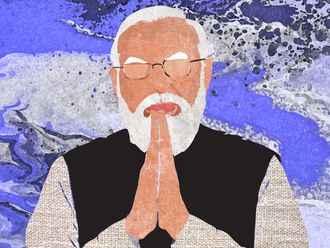January 30, 1948 was a fateful day for India. Television was still unknown by many, with the state-owned All India Radio (AIR) and newspapers being the only sources of dissemination of general information among the public. Radio was quicker as printed news reached the readers only the next morning, several hours after the occurrence.
We were in Aligarh, our home town in the then United Provinces of Agra and Oudh, known today as Uttar Pradesh. About 6pm, the city was plunged in shock. AIR had announced that the Father of the Nation, Mahatma Gandhi, had been assassinated. There was tension in the air and people talked in hushed tones.
India had gotten independence a mere six months earlier. Many were unable to believe that the apostle of peace, non-violence and social harmony could have been shot dead. Everybody was eager to know how it happened, where and why? But the details were not available immediately.
AIR broadcast Prime Minister Jawaharlal Nehru’s address to the nation and later gave details of the cremation that was to take place the next day.
As an inquisitive young lad in a politically conscious family, I lent my ears to all the discussions that took place — involving my grandfather, uncle, my father, cousins and a few neighbours — on the tragedy. Everywhere, tense people remained glued to the radio for long hours.
While providing information about the funeral procession’s route and cremation, AIR merely said that it would take place at Rajghat (which was then a little known place on the bank of the river Yamuna in Delhi). We in Aligarh had known only one Rajghat, which is on the banks of river Ganga in Uttar Pradesh’s Bulandshahr district. It later came to be known as Rajghat Narora.
In the tense atmosphere, my elders mistook Uttar Pradesh’s Rajghat for Delhi’s Rajghat and decided to take the family to pay homage to ‘Gandhiji’ there for the place was only about 40 miles (147km) from Aligarh. After hurriedly packing some snacks, we reached the railway station and boarded a train that was to leave shortly.
Suddenly, my elders realised that there was something amiss. There appeared to be no mourners like us on the solemn occasion. In fact, the train was less crowded than normal. Luckily, we heard some people quoting an AIR report on how a sea of people had swarmed Delhi’s roads leading to Rajghat on the banks of the Yamuna.
“My god!” my uncle exclaimed. The train was about to move. All of us quickly disembarked and retreated back home with the same speed that had taken us to the railway station — and once again got glued to the radio for the running commentary.
I was reminded of this 69-year-old anecdote in which the duplication of a name almost landed us in an unwarranted and embarrassing situation. Mercifully, the goof-up was detected and rectified in the nick of time. We were saved from the bother of landing at the wrong place.
Rajghat is only one example of how a particular name given to multiple cities, villages, colonies and localities in India can create confusion and typical situations. The same is true of individuals who bear the same name but may not be look alike like, such as the characters in Shakespeare’s Comedy of Errors.
Even a casual exercise would reveal that we have innumerable places known as Rampur and Ramnagar, particularly in the Hindi-speaking belt. Somehow these are among the most favoured names. Confusion would be a natural consequence. Likewise, there is a fair sprinkling of Rajnagars, Vijaynagars, Rajendranagars, Surajpurs, etc. As you travel in north India, you will come across plenty of Ganeshnagars, Vishnupuris, Lakshminagars, Sitapurs, Jankipurams, etc. Clearly these names have been derived from Hindu mythology. At the same time, there is no dearth of Mohammedpurs and Mehmoodpurs. Mughal rulers are also remembered through places like Akbarpur, Akbarabad, Shahjahanpur and the like
Not so far in the distant past, the most chosen names used to be Ramesh, Naresh, Suresh, Mahesh, Rajesh and the like. But in the wake of Indira Gandhi’s ascendance to power, there has been a spurt of Rajivs, Sanjays, Rahuls and Priyankas. This is not to suggest that these names were not known earlier. The point is that these days there is a crop of such identities. Why? It needs no elaboration.
As for the name given to a city, village or a locality, it understandably owes its origin to the ethos of the place. That is one way of remembering and paying reverence to one’s deity, saint, a martyr, some social reformer, a historical figure, a national hero or some scientist.
So, the message is clear: Don’t ask what is in a name? There is lot in it.
Lalit Raizada is a journalist based in India











